A big change is happening in finance. It’s making old ways of handling money seem outdated. This change is called decentralized finance (DeFi). It’s changing how we bank, invest, and do financial deals1.
But, not many people know about it yet. Only about 0.9% of money is in DeFi and crypto1. Despite this, it’s already bringing new services to the table. From liquidity provision to lending and borrowing platforms, DeFi is changing how we manage our money1.
The core of this change is blockchain technology. It makes a financial system that’s open and clear. With smart contracts and peer-to-peer networks, DeFi lets users do financial things without banks or brokers2.
Key Takeaways
- Decentralized finance (DeFi) is a fast-growing field that uses blockchain to create a fair, open, and easy-to-use financial world.
- DeFi services go from simple things like savings accounts to complex tasks like helping businesses or investors1.
- Places like Uniswap and PancakeSwap are big in DeFi. They let users swap cryptocurrencies directly, without needing a middleman2.
- DeFi lending and borrowing, as well as yield farming and liquidity mining, give users ways to make money from their digital assets.
- The DeFi world is always getting better, with new ideas and platforms popping up to tackle its challenges and risks.
What is Decentralized Finance?
Decentralized Finance, or DeFi, is a new way to handle money. It uses blockchain and cryptocurrencies for direct transactions without banks3. This makes money easier to get and use, making the financial world more open and fair3.
Definition and Overview
DeFi is built on blockchain, mainly on Ethereum4. It lets people lend, borrow, trade, and earn interest directly with each other. This is all thanks to smart contracts4.
Key Components of DeFi
DeFi has smart contracts, DApps, and cryptocurrencies4. Smart contracts do the work of agreements without needing anyone in the middle4. DApps offer many financial services on blockchain4. Cryptocurrencies like Ethereum make these services work by enabling transactions3.
Advantages of DeFi
DeFi is better than old ways of handling money because it’s more open and cheap3. It lets anyone with internet use financial services, making money more accessible to everyone3.
DeFi’s growth shows it can fix old money problems3. As it grows, it brings new chances and challenges for everyone3.
| Metric | Data Point |
|---|---|
| DeFi Market Share | DeFi made up two-thirds of the cryptocurrency market in terms of price changes in September 20203. |
| DeFi Collateral Levels | DeFi collateral levels reached $9 billion in September 20203. |
| Ethereum Developer Growth | Ethereum saw a rise in developers during 2020 due to the increased interest in DeFi3. |
| Crypto Market Valuation | The total value of crypto-assets is already valued at $2.5 trillion presenting a challenge for US regulators3. |
| Venture Capital Interest | Venture capitalists like Andreessen Horowitz and Michael Novogratz have shown interest in DeFi projects3. |
| DeFi Hacks | Bancor suffered a loss of $13.5 million in assets due to a hack in July 20183. |
Understanding DeFi’s parts, benefits, and growth is key4. It uses blockchain and cryptocurrencies to change finance for the better, making it more inclusive4.
The Evolution of Finance
The finance world has changed a lot, with DeFi shaking up the old system5. DeFi 2.0 brings new changes that are changing how we see finance.
Traditional Finance vs. Decentralized Finance
Before, finance relied on banks and big financial companies. Now, DeFi uses blockchain for secure, open, and unchangeable deals6. This big change is making finance look different.
The Role of Blockchain Technology
Blockchain is key to DeFi, making it possible for direct, safe deals. It cuts out middlemen, lowers costs, and makes finance more accessible7. New tech like AI and big data are making DeFi even better, leading to new ideas and better services.
Milestones in DeFi Development
DeFi has hit big marks, like the rise of DEXs and new DeFi projects5. DeFi 2.0 has brought better liquidity, security, and user experience. It also lets users have a say in how things are run, making finance more open and fair6.

“The shift towards decentralized finance represents a profound transformation in the way we approach financial services, empowering individuals and challenging the status quo.”
As DeFi grows, blockchain and decentralization will be key in shaping finance’s future567. This change is making finance more open, easy to get into, and giving users more power. It’s changing how we deal with money.
Core Principles of DeFi
Decentralized finance, or DeFi, is built on transparency, openness, and empowering users. These principles help create a financial system that’s more accessible and inclusive. It works without the need for traditional middlemen8.
Transparency and Openness
Transactions in DeFi are open to everyone on the blockchain. This makes the system trustworthy and accountable8. Users can see and check the flow of money, building trust and security8.
Interoperability
DeFi platforms work together smoothly, making it easy to use different services9. This connection lets users access many financial tools. They can lend, borrow, manage assets, and trade on decentralized exchanges in one place9.
User Empowerment
DeFi puts users in charge of their finances. They can manage their assets and take part in financial activities without middlemen9. This means they can lend, borrow, trade, and earn interest on their digital assets. They keep control and make their own decisions9.
DeFi aims to make finance more transparent, accessible, and focused on users. It wants to empower people and make finance more inclusive89.
“DeFi is not just about finance, it’s about empowering individuals and building a more inclusive financial ecosystem.” – DeFi Thought Leader
How DeFi Works
Decentralized Finance (DeFi) uses smart contracts to automate financial deals and follow set rules10. These smart contracts make it possible for things like token swaps, lending, and borrowing to happen without middlemen11.
Decentralized Exchanges (DEXs)
At the core of DeFi are decentralized exchanges (DEXs). They use automated market makers (AMMs) and liquidity pools for easy token swaps10. People can trade cryptocurrencies directly, without needing a central exchange11. This model is open and lets users control their assets better.
Lending and Borrowing Platforms
DeFi also makes peer-to-peer lending and borrowing possible. Users can lend out assets for interest or use their crypto as collateral to borrow10. These platforms work without banks, cutting costs and making things more accessible11.
| Key Features of DeFi | Description |
|---|---|
| Automated Market Makers | AMMs use algorithms to automatically set prices and facilitate trades, enabling decentralized token swaps. |
| Liquidity Pools | Users deposit their tokens into liquidity pools, which are then used by the AMM to facilitate trades, earning liquidity providers a share of the trading fees. |
| Peer-to-Peer Lending | DeFi platforms allow users to lend their crypto assets to borrowers, earning interest on their holdings. |
The DeFi world is growing, with new apps and platforms popping up all the time10. As DeFi gets better and laws change, it could really change how we think about money11.
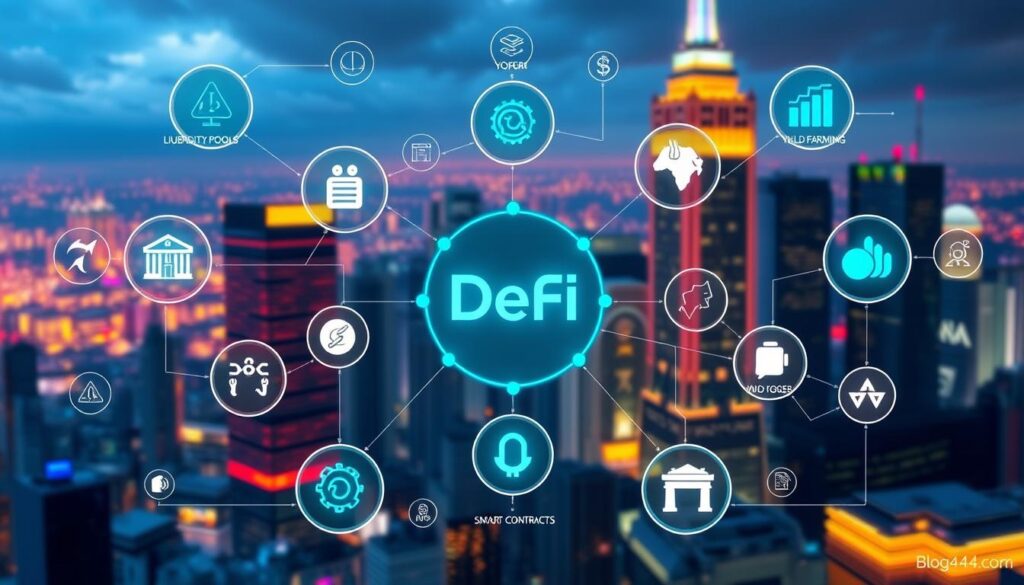
Popular DeFi Platforms
The DeFi world is growing fast, with many platforms becoming favorites. Ethereum is a top spot for DeFi apps, like Uniswap12 and Aave12. These platforms offer new ways to manage money.
Ethereum and Its Ecosystem
Ethereum’s blockchain is a big reason for DeFi’s success. It hosts Curve Finance12 for stablecoin trading and MakerDAO12 for its DAI stablecoin. These projects are making a big splash, giving users lots of financial options.
Binance Smart Chain
Binance Smart Chain (BSC) is a strong rival to Ethereum. It’s known for cheaper fees and quicker transactions. PancakeSwap12 on BSC is popular for its easy use, farming options, and fun features like lotteries and NFTs.
Other Emerging DeFi Solutions
While Ethereum and BSC lead, other networks are catching up. Solana, Cardano, and Polkadot are bringing new DeFi ideas. They’re making the DeFi world bigger and giving users more choices13. These newcomers will shape the future of DeFi.
| DeFi Platform | Key Features | Supported Cryptocurrencies | Transaction Fees |
|---|---|---|---|
| Uniswap | Leading DEX, user-friendly interface | Wide range of ERC-20 tokens | 0.3% |
| PancakeSwap | DEX on Binance Smart Chain, yield farming, gamified features | BEP-20 assets | Reduced fees compared to Ethereum |
| Curve Finance | Specialized in stablecoin trading | Stablecoins like USDT, DAI, USDC | 0.04% |
| Sushiswap | Wide selection of tokens, moderate minimum deposit | ERC-20 tokens | 0.3% |
| Binance DeFi | Over 300 cryptocurrencies, flexible minimum deposits, competitive fees | Variety of BEP-20 assets | Competitive in the DeFi market |
Choosing a DeFi platform means looking at security, features, fees, and user experience14. By checking these, you can find the best fit for you in the DeFi world131214.
Risks and Challenges of DeFi
The DeFi world is growing fast, but it faces big risks and challenges. These include security issues, unclear rules, and the ups and downs of the crypto market.
Smart Contract Vulnerabilities
Smart contracts are a big worry in DeFi. These self-running codes can have bugs that hackers exploit. Once deployed, fixing these issues is hard15. DeFi sites are often attacked because they handle a lot of money, putting user assets at risk15.
Regulatory Concerns
The rules for DeFi are always changing, causing uncertainty. DeFi sites must follow these rules, but it’s hard because they’re always shifting15. This makes it tough for DeFi to stay legal while keeping its open nature.
Market Volatility
The crypto market, which DeFi relies on, is very unstable. This instability affects DeFi sites and users15. Liquidity problems can make platforms unstable and harm users’ assets15. Also, the value of investments and loans can drop a lot, leading to big losses.
To deal with these risks, DeFi users need to do their homework. They should know the protocols they use and be careful. By staying informed and managing risks, users can handle the DeFi world better16.
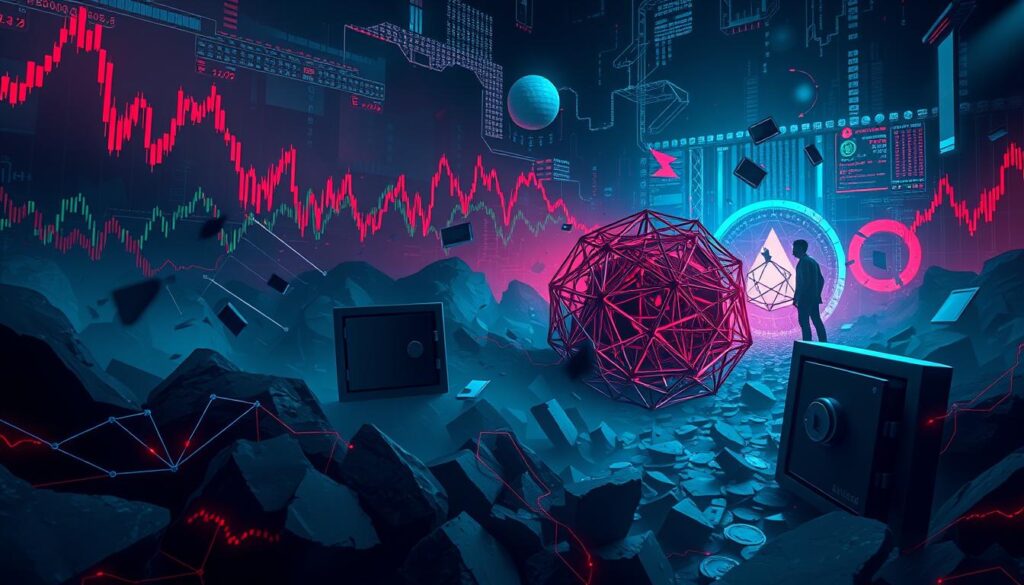
| Risk | Description | Potential Impact |
|---|---|---|
| Smart Contract Vulnerabilities | Flaws or bugs in the self-executing code that powers DeFi protocols | Hacks, theft of user funds, and platform integrity issues |
| Regulatory Uncertainty | Evolving and complex regulatory landscape for DeFi operations | Legal risks and challenges for DeFi platforms |
| Market Volatility | Extreme fluctuations in cryptocurrency prices and liquidity | Significant financial losses for users and platform instability |
“Navigating the risks and challenges of DeFi requires a thorough understanding of the ecosystem and a proactive approach to risk management.”
Getting Started with DeFi
Starting your DeFi journey means setting up a digital wallet. This wallet must work with DeFi apps. It’s your key to using DeFi platforms and protocols17.
Next, get some cryptocurrency like Ethereum or other tokens. You can buy these on trusted exchanges. Here, you can trade and sell digital assets17.
Choosing the Right DeFi Platform
With your wallet ready and crypto in hand, pick the right DeFi platforms. These apps offer services like exchanges, lending, and yield farming17.
Knowing blockchain and crypto basics is key. This knowledge helps you use DeFi safely and wisely. By setting up your wallet, getting crypto, and picking the right platforms, you’re ready to explore DeFi17.
“DeFi is the future of finance, and getting started is easier than you think. With the right tools and knowledge, anyone can explore the possibilities of decentralized finance.”
- Set up a secure, self-custodial digital wallet compatible with DeFi applications.
- Acquire cryptocurrency, such as Ethereum or other blockchain-based tokens, through reputable exchanges.
- Research and choose DeFi platforms that align with your financial goals and risk tolerance.
By following these steps, you’re ready to dive into DeFi. It’s important to stay informed and manage risks. The DeFi revolution offers exciting and empowering opportunities18.
| Metric | Value |
|---|---|
| Unique DeFi Users Worldwide | 7.5 million (peak in late 2021) |
| Projected DeFi Users by 2025 | North America: 10.31 million, Asia: 16.49 million |
| Total Value Locked (TVL) in DeFi | $87.5 billion (August 2024) |
| Stablecoin Market Cap | $162.36 billion (June 2024) |
| Tether (USDT) Market Cap | $125 billion (November 13, 2024) |
| USD Coin (USDC) Market Cap | $35.58 billion (November 14, 2024) |
Understanding DeFi Tokens
In the world of decentralized finance (DeFi), tokens are key. They power the apps and protocols in this fast-growing field. DeFi tokens are special cryptocurrencies for DeFi platforms. They help with transactions, governance, and access.
What Are DeFi Tokens?
DeFi tokens are digital assets for DeFi protocols or apps. They are used for transactions, governance, or to show ownership. Each token has its own purpose and utility.
Utility vs. Governance Tokens
DeFi tokens are mainly two types: utility and governance. Utility tokens give access to services or features. They let users use the platform’s functions. Governance tokens let holders vote on changes. They help shape the platform’s future.
Top DeFi Tokens to Watch
Watch tokens like UNI from Uniswap, AAVE from Aave, COMP from Compound, and MKR from Maker. These tokens are from top DeFi platforms. They’re popular among investors and users for their growth and innovative features19.
It’s important to understand DeFi tokens and their roles. Knowing about different tokens helps you make better choices in DeFi. This way, you can get the most out of DeFi protocols20.
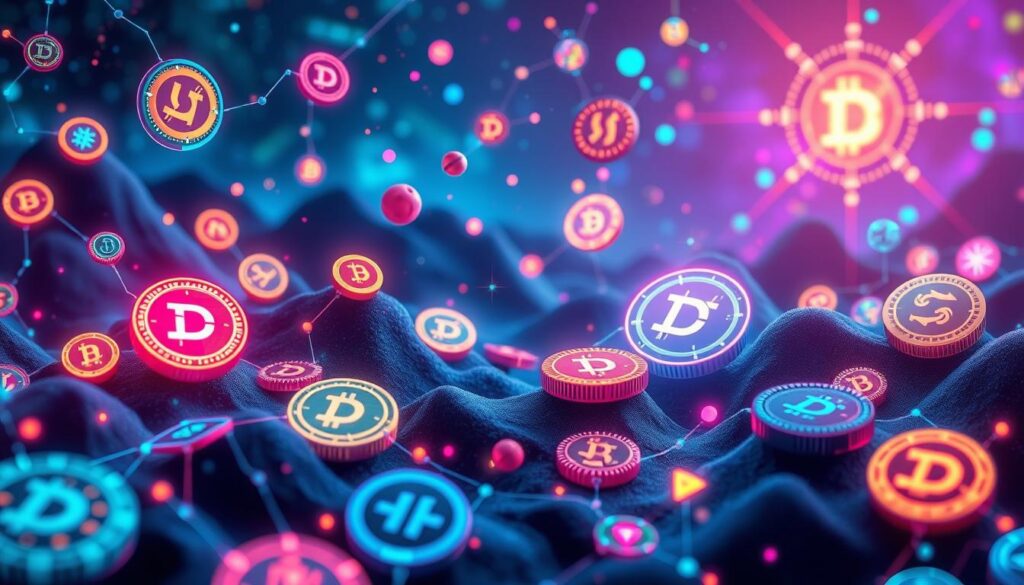
“DeFi tokens are the building blocks of the decentralized finance revolution, empowering users and driving innovation in the financial sector.”
Yield Farming and Liquidity Mining
In the world of decentralized finance (DeFi), yield farming and liquidity mining are key strategies for making money. Yield farming means lending or staking your crypto to pools, helping others borrow or trade. You get rewards and tokens for your share in the pool21.
What Is Yield Farming?
Yield farming lets you earn from the fees of platform transactions21. Platforms like Compound Finance and Uniswap are popular for this. You can use your rewards to invest in more pools, growing your crypto portfolio21.
How Liquidity Mining Works
Liquidity mining rewards users for adding liquidity to exchanges21. It’s grown fast, from $500 million to $10 billion in 202022. Sites like Uniswap are favorites for those looking to make money this way22.
Potential Returns and Risks
Yield farming and liquidity mining can be very profitable, with returns many times your initial investment22. But, they also come with big risks like smart contract bugs and market ups and downs21. It’s important to weigh the risks against the possible gains before starting.
“DeFi platforms offer provisions for liquidity, attracting investors with the promise of higher liquidity compared to other cryptocurrencies.”22
Yield farming and liquidity mining are getting more popular in DeFi. They offer a chance to make more money. By knowing the risks and how they work, you can make smart choices in this fast-changing field.
The Future of Decentralized Finance
Decentralized finance (DeFi) is growing fast, with new trends and innovations on the horizon. As more people start using DeFi, several key factors will help it grow and change.
Trends Shaping DeFi Growth
Perpetual Liquidity Pools (PLPs) are making it easier to manage liquidity in decentralized exchanges (DEXs)23. Intents-based architecture is making it simpler for users to interact with DeFi protocols23. This could lead to more people joining the DeFi world23.
Incentives like points and airdrops are helping to keep users engaged and adding liquidity to DeFi ecosystems23. Liquid staking protocols are making it easier to use staked assets, attracting more users23.
Cross-chain bridging is making it easier to move assets and data between different blockchain chains23. This is improving how different parts of DeFi work together23. Tokenizing real-world assets in DeFi is attracting traditional investors and financial institutions23. Prediction markets are also becoming a big part of DeFi, helping users make informed decisions23.
The Role of Regulation
As DeFi grows, so will the need for better regulations. Projects need to be compliant and transparent to gain trust and adoption23. Traditional financial institutions are starting to explore DeFi, bridging the gap between old and new finance23.
Innovations on the Horizon
DeFi is set for more innovation, with big steps forward in decentralized identity and privacy technologies23. These advancements will improve the user experience and encourage more people to use DeFi23. The future of DeFi is bright, with endless possibilities in decentralized finance.
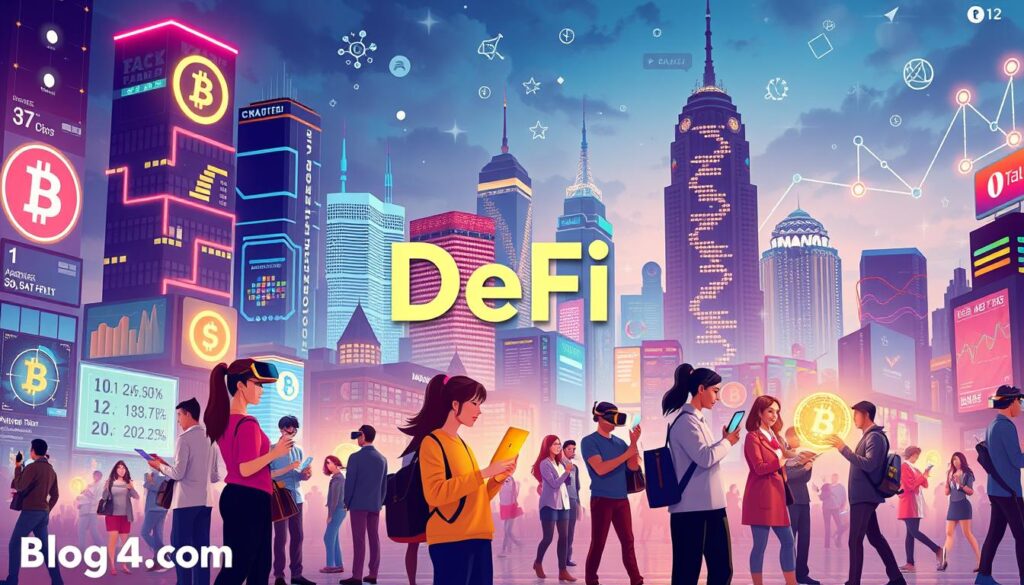
Real-World Applications of DeFi
DeFi is growing fast and moving into new areas. It’s not just about basic finance anymore. It’s changing traditional industries and making finance more open and fair. Let’s look at some cool ways DeFi is being used.
Decentralized Insurance
DeFi is changing insurance with new, decentralized ways to get coverage. These platforms don’t need old-school insurance companies. They offer clear and easy ways to manage risks, fitting each person’s needs24.
Real Estate and DeFi
DeFi and real estate are teaming up for new money models and chances to invest. Platforms are turning real estate into tokens, making it easier for more people to invest. Also, DeFi is making mortgage loans faster and cheaper for borrowers24.
Cross-Border Payments
DeFi is great for quick and cheap payments across borders. It uses blockchain to make international money moves easy. This is a big win for people and businesses doing business worldwide, saving money and time24.
As DeFi grows, we’ll see even more cool uses. It’s changing finance, insurance, and payments. DeFi is making finance more open and fair for everyone.
“DeFi is not just about finance; it’s about the democratization of finance, empowering individuals, and creating a more inclusive economic system.”
Social Impact of DeFi
Decentralized Finance (DeFi) has a big chance to help people get financial access. It can help those who don’t have bank accounts or can’t use traditional banking. DeFi makes it easier for people to save, borrow, and invest, opening doors to new opportunities.
Providing Financial Access
DeFi uses smart contracts to let people borrow, lend, trade, and invest without banks. This is great for those who can’t get to banks because of where they live or their financial situation. DeFi makes money moves cheaper and faster, helping more people get financial services.
Empowering Unbanked Populations
Billions of people can’t use traditional banks because of where they live or their money situation. DeFi can change this by using blockchain to offer services like savings and loans. This could really help people who are left out of the banking world, giving them a chance to grow their money and improve their lives.
Community-Driven Projects
DeFi is also behind projects that help solve big social and economic problems. These projects, often run by DAOs, use DeFi to meet local needs. They work on things like affordable housing, healthcare, and helping the environment, showing DeFi’s wide range of uses for good.
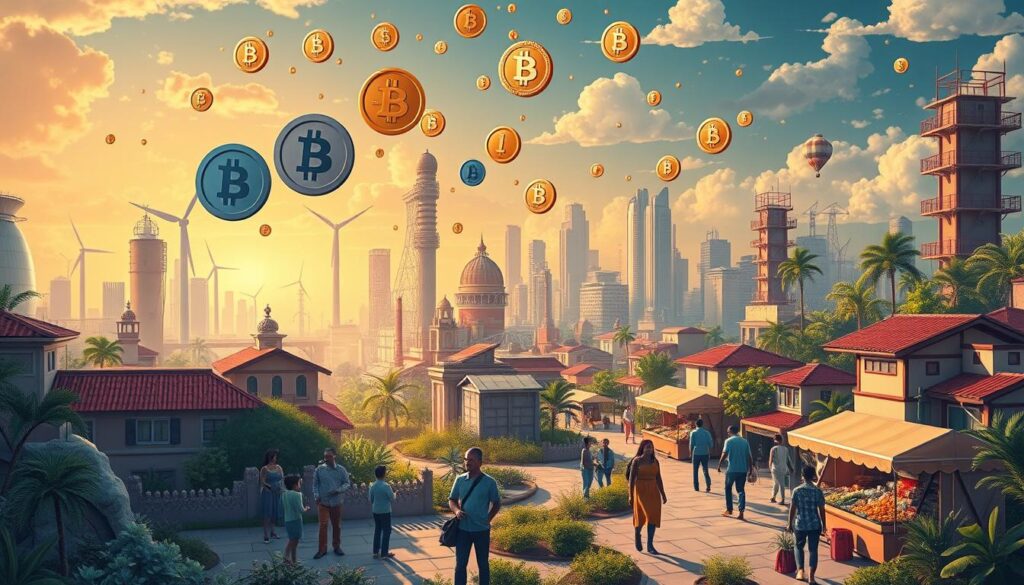
As DeFi grows, it’s clear it can make the financial world more fair and open. It can help people who don’t have bank accounts, support community projects, and use blockchain’s benefits. DeFi is set to make a big difference in how we handle money and help people worldwide.
| DeFi Impact | Key Benefits |
|---|---|
| Financial Access |
|
| Empowering Unbanked |
|
| Community-Driven Projects |
|
“DeFi has the power to make financial services available to everyone, helping those who have been left out for too long.”25
The social impact of DeFi shows how it can change the world. It breaks down barriers, brings people together, and helps solve big problems. DeFi is leading the way to a fairer and more open financial future for all2625.
Best Practices for Engaging in DeFi
Exploring decentralized finance (DeFi) needs careful steps. You must research, manage risks, and keep up with news. These steps help you use DeFi safely and smartly, avoiding common mistakes.
Research and Due Diligence
Always do your homework before using any DeFi platform. Learn about the smart contracts, check security audits, and know the team and their plans27. Unlike banks, DeFi doesn’t have strict rules or audits, making it harder to keep things safe27.
DeFi struggles to enforce rules like knowing who’s using it because there’s no single authority27.
Managing Risk and Investments
Managing risks well is key in DeFi. Spread your investments, set realistic goals, and remember that crypto markets can be wild28. Use advanced tools to trade better28.
Learn how to use tools like stop-loss orders to handle price changes28.
Staying Informed about Market Trends
The DeFi world is always changing. Keep up with new tech, rules, and trends to make smart choices27. Smart contracts in DeFi can’t be changed, which makes following laws tricky2729.
Watch how people’s views on DeFi change as more look for new ways to manage money28.
By following these tips, you can move through DeFi with confidence. Focus on27 security, managing risks, and keeping up with the latest28 crypto news.
Conclusion and Next Steps
Decentralized finance (DeFi) is changing how we get and use financial services. It brings both chances and challenges. It’s key to be both curious and careful when diving into it30.
To join the DeFi movement, look for learning materials and connect with the crypto community. Keep up with new things in this fast-changing field3031. Ethereum and Binance Smart Chain are at the forefront, with many DeFi tools and services changing finance31.
When you start exploring DeFi, always think about your safety and managing risks. DeFi can lead to more financial access and creativity, but it also has its own dangers30. By staying informed and being careful, you can move through DeFi safely. This could open up new ways to improve your finances32.
FAQ
What is Decentralized Finance (DeFi)?
DeFi is a new way to handle money using blockchain. It wants to make finance open and fair for everyone. You can lend, borrow, and invest without banks.
What are the key components of DeFi?
DeFi uses smart contracts, apps, and crypto. It works on the internet, making deals safe and clear for all.
What are the advantages of DeFi?
DeFi is easy to use, clear, and cheap. It lets anyone with the internet use finance services, making it fair for all.
How does DeFi differ from traditional finance?
DeFi doesn’t need banks, using the internet instead. It makes deals safe and clear, changing finance forever.
What are the core principles of DeFi?
DeFi is open, clear, and lets users control their money. Deals are public, and you can use many services without banks.
How do DeFi protocols work?
DeFi uses smart contracts for deals. Exchanges and lending platforms work without banks, making finance easier.
What are some of the popular DeFi platforms?
Ethereum is big for DeFi, with Uniswap and Aave. Binance Smart Chain is growing, with lower fees. More platforms are coming, adding services.
What are the risks and challenges associated with DeFi?
DeFi can be hacked, and the market can be unstable. Always check before using DeFi, to avoid big losses.
How can I get started with DeFi?
Start with a digital wallet and crypto. Choose safe DeFi platforms. Learn about blockchain and crypto to use DeFi safely.
What are DeFi tokens, and how do they work?
DeFi tokens are for DeFi apps. They can unlock services or let you vote. Know what tokens do before investing.
What is yield farming and liquidity mining in DeFi?
Yield farming and mining offer high returns. But, they can be risky. Always weigh the risks before starting.
What are the future trends and innovations in DeFi?
DeFi will grow, with better tech and more services. Rules might change, but DeFi will keep improving.
What are some real-world applications of DeFi?
DeFi is used in insurance, real estate, and payments. It’s changing how we handle money in many ways.
How can DeFi have a positive social impact?
DeFi can help the poor and unbanked. It opens doors to savings and loans, making a big difference.
What are the best practices for engaging in DeFi?
Research and be careful with DeFi. Manage risks and stay updated to use DeFi safely and wisely.

















